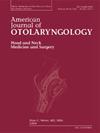Comparison of cartilage myringoplasty for repairing non-cholesteatomatous chronic perforation with mastoid cavity pneumatization and opacification
IF 1.8
4区 医学
Q2 OTORHINOLARYNGOLOGY
引用次数: 0
Abstract
Objective
The objective of this study was to compare the graft outcomes of cartilage myringoplasty for the repair of chronic otitis media (COM) with a complete ossicular chain between mastoid cavity pneumatization and opacification.
Materials and methods
Chronic perforations with non-cholesteatomatous COM were allocated to either mastoid cavity pneumatization (MCP) group and opacification (MCO) group. All patients underwent endoscopic cartilage underlay myringoplasty alone. The graft success rate, audiometric outcomes, soft tissue opacification change, and complications were evaluated at 12 months after surgery.
Results
The postoperative infection was 2.7 % patients in the MCP group and 8.1 % patients in the MCO group (P = 0.607). Overall graft success rates were 91.9 % in the MCP group and 89.2 % in the MCO group (P = 0.691). MCO group exhibited more deterioration in preoperative air conduction (AC) PTAs (P = 0.047) or pre-operative ABG (P = 0.039) compared with MCP group, while there were no significant differences between the groups in postoperative AC PTAs, BC PTAs, or ABGs. Nevertheless, MCO group exhibited better ABG gain compared with MCP group (21.2 ± 6.9 vs 13.8 ± 2.6 dB; P = 0.024). Temporal bone CT at postoperative 12 months revealed no change in opacification in 56.8 % patients and reduced opacification or complete pneumatization in 43.2 % patients in the CMO group. Also, none of the patients developed worsening sensorineural hearing loss or postoperative tinnitus.
Conclusions
Myringoplasty alone did not affect the graft success rate in the patients with mastoid cavity pneumatization or opacification, however, in comparison, the patients with mastoid cavity opacification had a worse preoperative hearing but better postoperative hearing recovery. In addition, myringoplasty alone could improve the mastoid cavity opacification.
软骨鼓膜成形术修复非胆脂瘤性慢性穿孔伴乳突腔充气及混浊的比较
目的比较软骨鼓膜成形术修复慢性中耳炎(COM)的效果,在乳突腔气化和浑浊之间形成完整的听骨链。材料与方法将非胆脂瘤性COM慢性穿孔分为乳突腔气化(MCP)组和混浊(MCO)组。所有患者均行内窥镜下软骨下鼓膜成形术。术后12个月评估移植物成功率、听力学结果、软组织混浊改变和并发症。结果MCP组术后感染率为2.7%,MCO组为8.1% (P = 0.607)。MCP组和MCO组移植成功率分别为91.9%和89.2% (P = 0.691)。与MCP组相比,MCO组术前空气传导(AC) PTAs (P = 0.047)和术前ABG (P = 0.039)恶化更严重,而术后AC PTAs、BC PTAs、ABG组间差异无统计学意义。然而,与MCP组相比,MCO组表现出更好的ABG增益(21.2±6.9 vs 13.8±2.6 dB;p = 0.024)。术后12个月颞骨CT显示56.8%的患者未见混浊改变,43.2%的CMO组患者混浊减轻或完全气化。此外,没有患者出现感觉神经性听力损失恶化或术后耳鸣。结论乳突腔气化或浑浊患者单独行乳膜成形术不影响移植物成功率,但乳突腔浑浊患者术前听力较差,术后听力恢复较好。单独行鼓膜成形术可改善乳突腔混浊。
本文章由计算机程序翻译,如有差异,请以英文原文为准。
求助全文
约1分钟内获得全文
求助全文
来源期刊

American Journal of Otolaryngology
医学-耳鼻喉科学
CiteScore
4.40
自引率
4.00%
发文量
378
审稿时长
41 days
期刊介绍:
Be fully informed about developments in otology, neurotology, audiology, rhinology, allergy, laryngology, speech science, bronchoesophagology, facial plastic surgery, and head and neck surgery. Featured sections include original contributions, grand rounds, current reviews, case reports and socioeconomics.
 求助内容:
求助内容: 应助结果提醒方式:
应助结果提醒方式:


